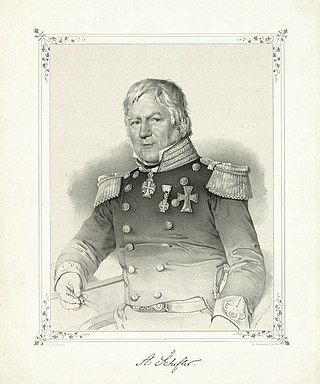Søehesten was an 18-gun barge of the Royal Dano-Norwegian Navy, commissioned in 1795. During the Battle of Copenhagen on 2 April 1801, it was commanded by Lieutenant B. U. Middelboe with a complement of 178 sailors. 12 of the ship's crew were killed in the battle, and 21 wounded. The ship struck its colours at 14.30.

HMS Trident was a 64-gun third rate ship of the line of the Royal Navy, launched on 20 April 1768 at Portsmouth. On 30 January 1772 in Gibraltar harbour during a severe winter storm the Danish ship-of-the-line Prinsesse Wilhelmine Caroline dragged its anchor, colliding with the bow of HMS Trident before running aground.
HDMS Søormen was a 12-gun cutter of the Royal Dano-Norwegian Navy, built in 1789. After being captured by the British in 1808 she was added to the Royal Navy as HMS Salorman. She was wrecked in 1809.
HDMS Lolland was launched in March 1810. She served in at least four major engagements during the Gunboat War before she was transferred to the Norwegian navy after the Treaty of Kiel brought about the separation of Norway from Denmark in 1814. Lolland continued to serve with the Norwegian Navy until sold in 1847.

HDMS Elephanten was a ship of the line of the Royal Dano-Norwegian Navy that served from 1703 to 1728. There were three other Danish ships-of-the line of the same name, dating from 1684, 1741 and 1773. The ship was sometimes referred to as Nye Elefant to differentiate from others of similar name. For much of her service career, which coincided with the Great Northern War, Elephanten was the flagship of the Danish fleet active in the Baltic Sea.

HDMS Bellona was a frigate of the Royal Danish Navy, which she served from 1835 to 1862.
HDMS Friderichsværn was a Danish frigate built at Nyeholm, Copenhagen, in 1783. The British Royal Navy captured her in 1807 and took her into service as HMS Frederickscoarn. It sold her in 1814.
HDMS Hvide Ørn , was a light frigate designed by Frantz Hohlenberg and built in Copenhagen. She capsized and was lost with all hands off Corsica at the end of 1799. There were three previous ships bearing this name in the Danish navy. The name was after the loss of the ship retired. An 1898 model of the ship is in the collection of the Royal Danish Naval Museum.
This list of Danish shipbuilders, arranged by year, presents builders of Danish warships from the late 17th century to mid-19th century. It names the Heads of Naval Construction (Fabrikmester) and includes lesser shipbuilders to the Danish Royal Navy. It does not include purely commercial shipbuilders.

Frederik Michael Krabbe (1725–1796) was a Danish naval officer and master shipbuilder (fabrikmester)

Diderich de Thurah (1704–1788) was a military cadet, a naval officer in the Royal Danish-Norwegian navy, shipbuilder and fabrikmester, artist and publisher.

Andreas Schifter (1779–1852) was a Danish naval officer and shipbuilder, a capable naval administrator and admiral. He oversaw the transition of the Danish navy from sail to early steam power.
HDMS Ørnen (1694) was a frigate in the Royal Danish Navy active during the Great Northern War

Michael Bille (1680–1756) was an officer in the Danish Royal Navy during the Great Northern War. He was commissioned as a junior lieutenant in 1699, advancing steadily to become Vice Admiral when he retired in 1737.

Daniel Ernst Bille was a naval officer and rear admiral in the service of the Danish crown.
Olfert Fasvier Fischer was a naval officer in the service of the Danish crown who became a director of the Danish Asia Company and completed his career as a vice admiral.

HDMS Triton was a Danish frigate launched in 1790 which operated in Danish/Norwegian home waters and in the Mediterranean in the protection of Danish merchant ships - not only from Barbary pirates but also from potential British privateers. The period in which it operated was fraught with political and practical difficulties which led to two battles at Copenhagen and other, lesser, actions.
De Fire Søstre was the name of five separate ships which served purely as merchant ships or, for part of their lives, hospital and supply ships to the Danish fleet.

HDMS Justitia was a 72-gun ship of the line of the Royal Dano-Norwegian Navy built to a design by Henrik Gerner. Although launched in 1777, she was not fully commissioned until 1780. The Royal Navy captured her in 1807 together with the most of the Dano-Norwegian navy after the battle of Copenhagen in 1807. The British never commissioned Justitia. A renaming to Orford in 1809 was cancelled. She was broken up in 1817.

HDMS Justitia was a ship-of-the-line designed by Ole Judichaer built at Nyholm, Copenhagen for the Royal Danish-Norwegian Navy.












